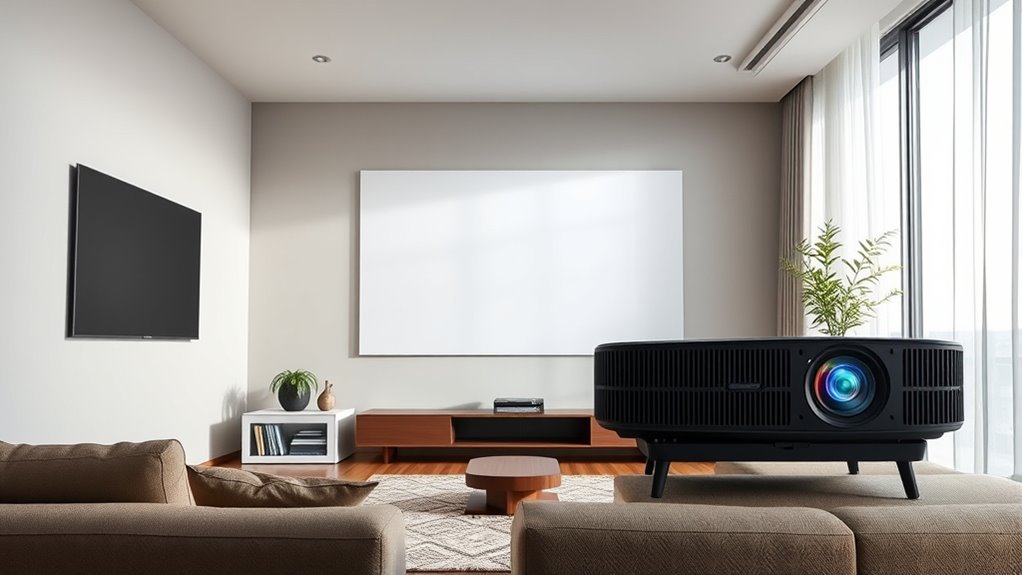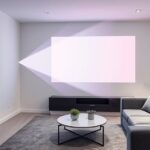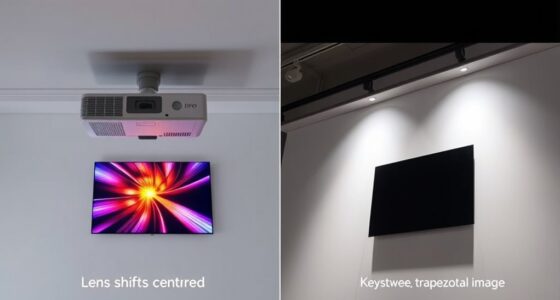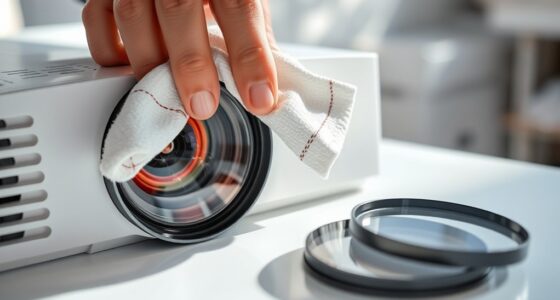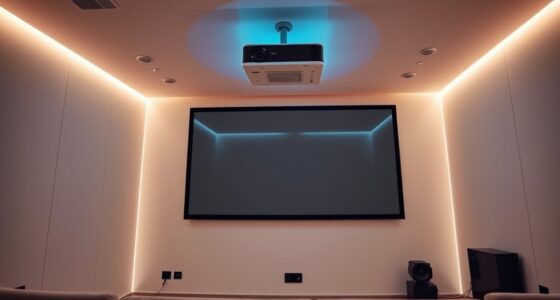When choosing between short-throw and ultra short-throw projectors, consider your space: ultra short-throw models need just inches from the wall, making them perfect for small or cluttered rooms, while short-throw projectors require a few feet of space for larger images, suited for bigger rooms. Both offer space-saving benefits but differ in installation and placement flexibility. Keep exploring to discover which option best fits your room and viewing needs.
Key Takeaways
- Ultra short-throw projectors require just inches of space, ideal for small or cluttered rooms, while short-throw projectors need several feet of clearance.
- Ultra short-throw models are easier to install in tight spaces, often wall-mounted close to the screen, unlike short-throw units that need more room.
- Both types save space compared to traditional projectors, but ultra short-throw projectors maximize space efficiency in limited areas.
- Ultra short-throw projectors are portable and flexible for small rooms, whereas short-throw projectors suit larger spaces with higher ceilings.
- Placement and setup complexity vary: ultra short-throw projectors demand precise positioning but occupy less space; short-throw projectors offer more installation options.
Understanding Short-Throw and Ultra Short-Throw Projectors
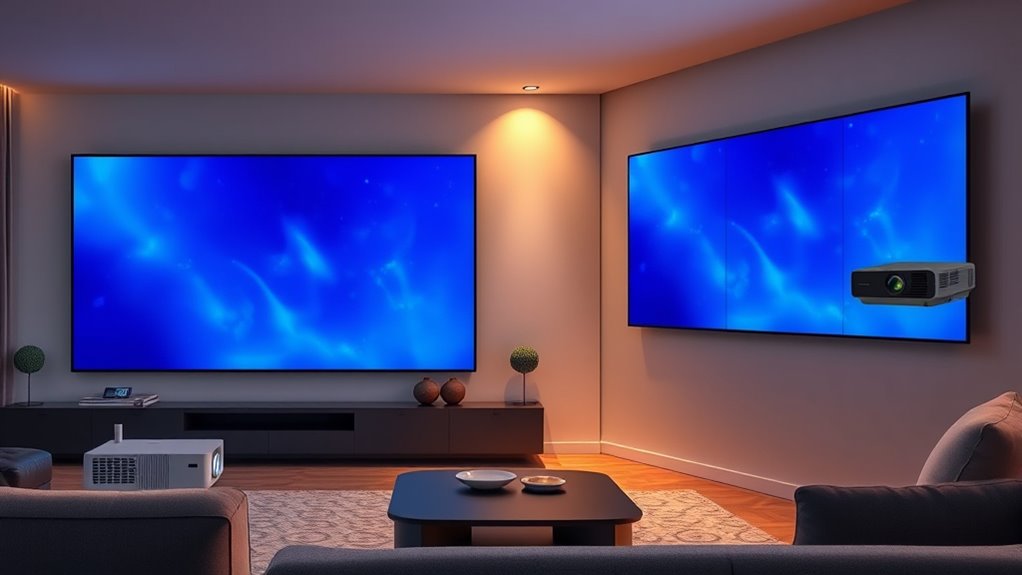
Short-throw and ultra short-throw projectors are designed to save space by projecting large images from very close to the screen or wall. This proximity doesn’t compromise image clarity; in fact, many models deliver sharp, detailed visuals even at short distances. The projector brightness plays a vital role here, ensuring vibrant images without blurring or dimming, especially in well-lit rooms. Short-throw projectors typically need to be a few feet from the wall, while ultra short-throw models can be positioned just inches away. Both types are ideal for small rooms or spaces where conventional projectors might be impractical. When choosing, consider how much brightness you need to maintain clear, vivid images, ensuring your viewing experience remains sharp and immersive. Additionally, screen size and placement are important factors to optimize the viewing experience and make the most of your space. Proper bulb maintenance can also extend the lifespan of your projector, ensuring consistent image quality over time. Moreover, understanding the contrast ratio can help you select a projector that provides deeper blacks and more vibrant images in your setting. As technology advances, AI-enhanced features are increasingly integrated into projectors to optimize image quality and user experience. It’s also helpful to review installation options to ensure the setup fits your room layout and viewing preferences.
Key Differences in Projection Distance and Placement
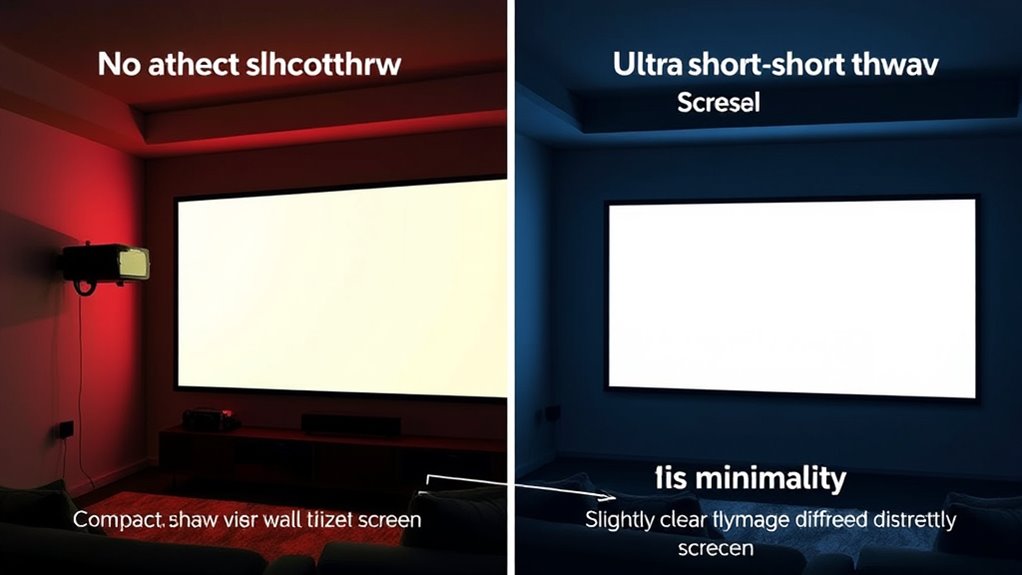
You’ll notice that ultra short-throw projectors need just inches of space from the screen, making them ideal for small rooms, while short-throw models require several feet. This difference affects how you install them and how flexible your setup can be. Consider your room size and placement needs to choose the right projector for your space. Additionally, understanding projection technology can help optimize your viewing experience and ensure optimal image quality in your environment. Being aware of installation requirements can further assist in planning your setup for both types of projectors. Recognizing room layout is also crucial to ensure proper positioning and avoid shadows or obstructions during use. Incorporating industry trends into your knowledge can help you stay updated on the latest advancements and features available for these projectors.
Projection Distance Range
While both short-throw and ultra short-throw projectors are designed to save space, they differ markedly in their required projection distances. Short-throw projectors typically need to be placed about 3 to 8 feet from the screen, depending on the model and desired image size. Ultra short-throw projectors, however, can be positioned just inches away from the wall or screen, often less than 2 feet. The projection angle plays an essential role in determining placement, especially with ultra short-throw units that require a precise angle to project correctly. If you plan to ceiling mount your projector, keep in mind that ultra short-throw models generally have a shorter projection distance, making them more suitable for tight spaces. This difference impacts your setup and room layout considerably. Additionally, the placement requirements are often influenced by security considerations, such as the need to avoid obstructing pathways or creating hazards in shared spaces. Proper installation techniques are crucial to optimize image quality and safety in both cases, and understanding the specific projection distance range helps ensure optimal placement and performance. Furthermore, considering the ambient lighting conditions in your room can significantly affect your choice of projector and placement.
Installation Flexibility
The installation flexibility of short-throw and ultra short-throw projectors varies considerably due to their differing projection distances. Short-throw projectors require more space from the screen, limiting mounting options and ceiling height choices. Ultra short-throw models sit very close, offering more placement versatility, especially in tight spaces. If you have a low ceiling, ultra short-throw projectors are easier to install without sacrificing image quality.
| Aspect | Short-Throw | Ultra Short-Throw |
|---|---|---|
| Mounting options | Limited due to distance | Broad, close-up placement |
| Ceiling height | Needs higher ceilings | Works well in low-ceiling rooms |
| Flexibility | Moderate | High, ideal for tight spaces |
Room Size Compatibility
Thanks to their differing projection distances, short-throw and ultra short-throw projectors suit different room sizes and setups. Short-throw projectors require more space between the projector and the screen, making them suitable for medium to large rooms with higher ceilings. Ultra short-throw projectors, placed just inches from the wall or screen, excel in smaller spaces where space is limited. Ambient lighting plays a role too; ultra short-throw models work better in rooms with more ambient light because they produce brighter images at close range. Ceiling height also matters—higher ceilings give more flexibility for short-throw projectors, while ultra short-throw models can be positioned on a low table or mounted very close to the wall, saving space and accommodating various room dimensions. Digital literacy programs also support the adoption of these projectors by teaching users how to optimize setup and usage in their specific environments. Additionally, understanding projection technology helps users select the right model for their space and enhances overall viewing experience.
Image Size and Quality Considerations

Choosing the right projector setup substantially impacts both image size and quality. With short-throw and ultra short-throw projectors, you’ll notice differences in image resolution, which directly affects how detailed and clear your picture appears. Higher resolution results in sharper images and better picture sharpness, especially when projecting large sizes. Ultra short-throw models often excel in maintaining image quality at close distances, providing crisp visuals without sacrificing resolution. Conversely, some short-throw projectors may offer lower resolution, leading to less sharpness when enlarging images. Keep in mind that projecting a larger image requires a projector with sufficient resolution to prevent blurriness and pixelation. Additionally, understanding the recognition and identification of angel numbers can help you choose the right settings to align with your intentions. Ensuring your projector has robust safety measures can also prevent potential malfunctions and protect your investment. It is also essential to consider the current news in Indonesia for updates on technology trends and innovations that could influence your projector choice. Factoring in remote work productivity insights can help optimize your space for better viewing experiences. Moreover, considering filter maintenance and care can extend the lifespan and performance of your projector components. Ultimately, balancing image resolution and the projector’s capabilities ensures you get a bright, clear, and sharp picture, regardless of the size.
Space Requirements and Room Layout Flexibility
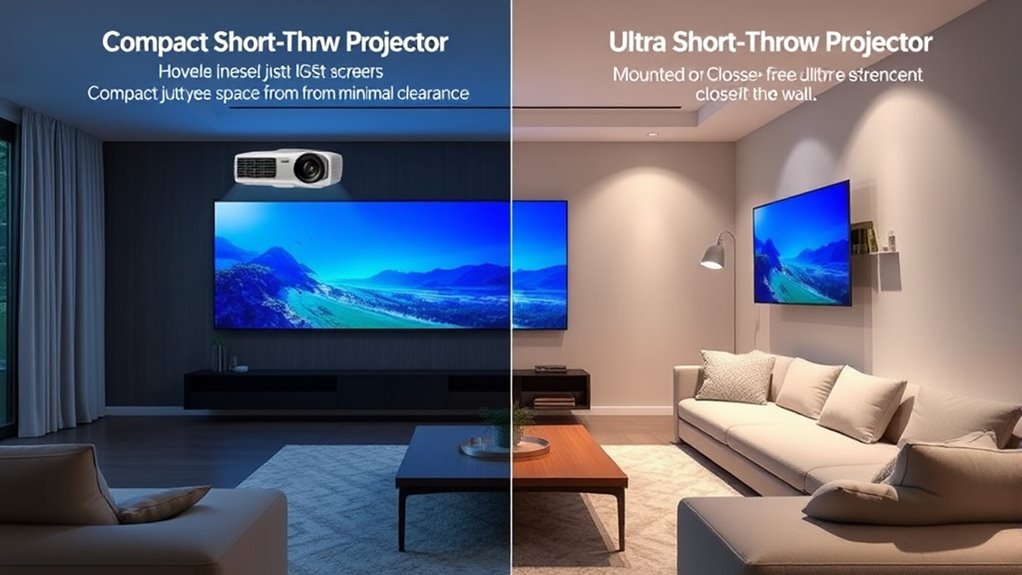
Your room size and layout play a big role in choosing between short-throw and ultra short-throw projectors. Short-throw models need more distance from the screen, which might limit placement options, while ultra short-throw units can fit into tighter spaces. Consider how flexible you want your setup to be and whether your room allows for easy positioning of the projector. Additionally, understanding vacuum features can help you optimize your overall space for cleaning and maintenance. Being aware of projection angles is also crucial to ensure optimal image quality and avoid distortion or shadows during use.
Distance From Screen
When considering the space needed for a projector, the distance from the screen plays a crucial role in determining room layout and flexibility. Short-throw projectors must be placed relatively close to the screen, typically within a few feet, making them ideal for smaller spaces. Ultra short-throw models sit even closer, often just inches away from the screen, allowing for more flexible room arrangements. The distance impacts the achievable screen size; shorter throw projectors can produce large images from close distances, but ambient light can affect image clarity, especially in brighter rooms. By understanding these distance requirements, you can optimize your room setup to balance space constraints, desired screen size, and lighting conditions for the best viewing experience.
Room Size Compatibility
Room size compatibility plays a significant role in selecting the right projector, as it determines how well the device fits within your space and how flexible your room layout can be. With short-throw and ultra short-throw projectors, space requirements vary based on desired screen size and ambient light conditions. Short-throw projectors typically need more distance from the screen, making them suitable for larger rooms with controlled lighting. Ultra short-throw models can project large images from very close, ideal for small or cluttered spaces. Consider your room’s size and ambient light levels to choose a projector that provides ideal screen size without sacrificing image quality. Here’s a quick comparison:
| Feature | Short-Throw | Ultra Short-Throw |
|---|---|---|
| Space Needed | Moderate to large | Very minimal |
| Ambient Light Impact | Moderate | Low, good for bright rooms |
| Screen Size Flexibility | Wide range | Large screens from close |
| Room Layout Flexibility | Less adaptable | Highly adaptable |
Flexibility in Placement
Choosing between short-throw and ultra short-throw projectors hinges considerably on how flexible their placement options are within your space. Short-throw projectors typically require more distance from the screen, limiting mounting options and room layout flexibility. Ultra short-throw models, on the other hand, can be placed extremely close to the wall or screen, making them ideal for tight spaces and minimizing wiring clutter. Portability considerations also come into play; ultra short-throw projectors are often more compact and easier to move around, offering greater flexibility for different room setups. Your choice depends on your room’s size, layout, and how often you might want to relocate the projector. Overall, ultra short-throw projectors provide superior placement flexibility, especially in limited spaces.
Installation and Setup Ease

Installing and setting up short-throw projectors is generally straightforward, but the process can vary considerably between models. Your main considerations include mounting options and the calibration process. Some projectors offer flexible mounting choices like ceiling, wall, or tabletop, simplifying setup. Others may require precise placement for ideal image quality. The calibration process can also differ; many models include automatic adjustments, while others need manual fine-tuning. Here’s a quick comparison:
| Feature | Short-Throw | Ultra Short-Throw |
|---|---|---|
| Mounting options | Flexible (ceiling, wall, tabletop) | Usually wall-mounted |
| Calibration process | Often automatic or simple manual | Typically more precise |
| Ease of setup | Generally easy | Slightly more involved |
Cost and Budget Implications
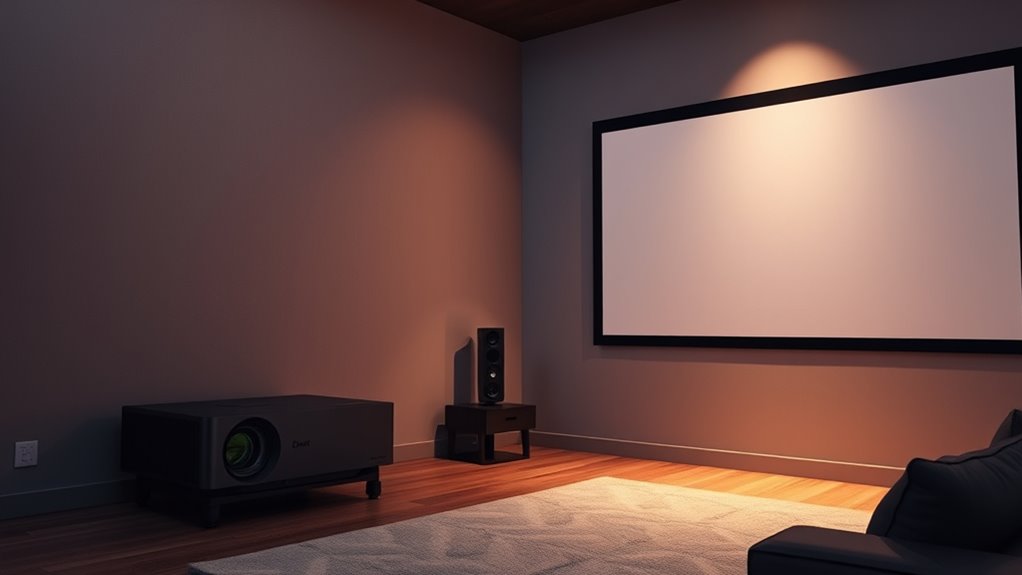
While shorter-throw projectors may be easier to set up, their cost can vary substantially based on features and quality. If you have strict budget constraints, you’ll need to carefully compare prices to find options that balance affordability with performance. Ultra short-throw models often come with a higher price tag due to advanced optics and technology, but they can save space and reduce installation costs. Conduct a thorough price comparison to determine which projector fits your budget while meeting your needs. Keep in mind that cheaper models may lack some premium features, so weigh the long-term value against initial costs. Ultimately, your choice depends on your budget and what features matter most for your space and usage.
Compatibility With Existing Home Theater Systems

Compatibility with existing home theater systems is a essential consideration when selecting between short-throw and ultra short-throw projectors. You’ll want to guarantee seamless audio integration, so your sound system works smoothly with the projector’s audio output. Both types often support various audio connections, but double-check compatibility with your current setup. Wireless connectivity is also critical; many projectors now offer Wi-Fi or Bluetooth options, allowing you to stream content directly or connect wirelessly to speakers and streaming devices. Ultra short-throw projectors typically have more advanced wireless features due to newer technology, making integration easier. Before purchasing, verify that your home theater components—like receivers, speakers, and streaming devices—can connect effortlessly, ensuring a clean, clutter-free setup with minimal fuss.
Maintenance and Durability Factors

Maintenance and durability are crucial factors to take into account because they directly impact the long-term performance and cost of your projector. With shorter bulb lifespans, especially in ultra short-throw models, you’ll need to plan for more frequent replacements, which can add to your expenses. A consistent maintenance schedule helps guarantee your projector stays in top condition, preventing dust buildup and overheating issues. Ultra short-throw projectors often require more careful handling due to their compact design, while short-throw models tend to be more accessible for routine upkeep. Both types benefit from regular cleaning and timely bulb replacements, but understanding their durability differences allows you to choose a model that fits your maintenance capabilities and budget over time.
Making the Right Choice for Your Space
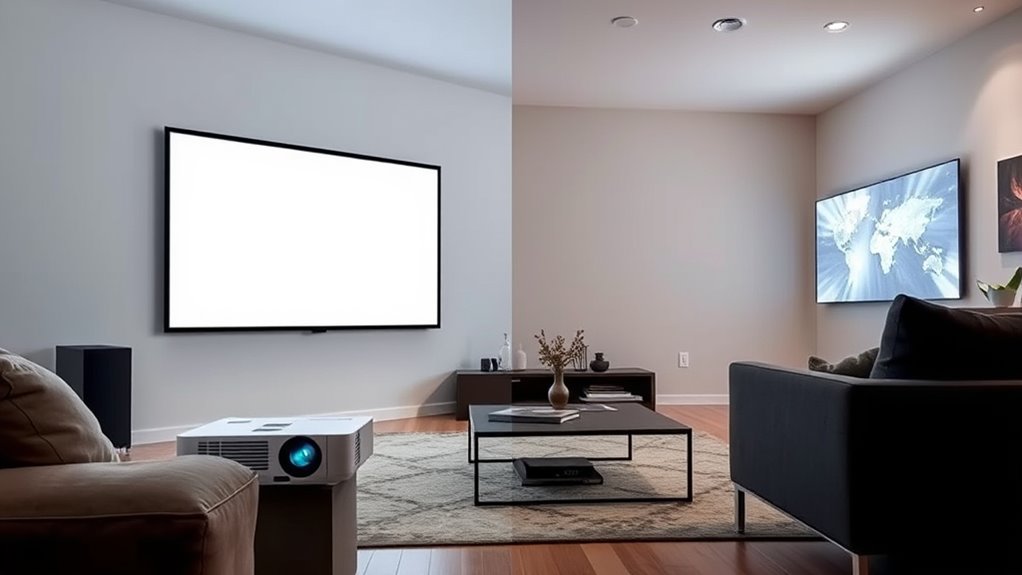
Choosing between a short-throw and an ultra short-throw projector depends largely on your available space and how you plan to use it. If your room has ambient lighting, an ultra short-throw projector can be more effective, as it minimizes shadows and glare, providing a brighter image. Consider your audio needs too; look for models with good audio integration to avoid extra equipment cluttering your space. If you have limited room, an ultra short-throw projector allows you to place it very close to the screen, saving space. On the other hand, a short-throw projector might be suitable if you have a slightly larger setup and want more flexibility. Ultimately, assess your room’s size, lighting conditions, and audio preferences to make the best choice.
Frequently Asked Questions
Which Projector Type Offers Better Image Quality at Short Distances?
When choosing a projector for short distances, you want to prioritize image clarity and color accuracy. Generally, ultra short-throw projectors tend to deliver better image quality at close range because they use advanced optics for sharper, more vibrant images. Short-throw models can also be good, but they might not match the ultra short-throw’s precision in color and detail. Your choice depends on your specific space and quality preferences.
Are Ultra Short-Throw Projectors More Prone to Image Distortion?
While ultra short-throw projectors are highly convenient, they can sometimes face slight challenges with image distortion. This mainly occurs if lens alignment isn’t perfect or if keystone correction isn’t properly adjusted. Fortunately, modern models often feature advanced lens technology to minimize these issues. With careful setup, you can enjoy a clear, distortion-free image, making these projectors a great space-saving choice without sacrificing quality.
Can Both Types Be Installed on Existing Home Theater Mounts?
You can install both ultra short-throw and short-throw projectors on existing home theater mounts, but mount compatibility varies. Ultra short-throw projectors often require specialized mounts due to their unique placement needs, offering better installation flexibility. Short-throw models generally fit standard mounts, making setup easier. Always check your projector’s specifications and your mount’s compatibility to guarantee a secure, seamless installation.
How Does Ambient Light Affect Short-Throw Versus Ultra Short-Throw Projectors?
Ambient light interference impacts both short-throw and ultra short-throw projectors, but ultra short-throw models generally handle ambient light better due to their higher lumen output. You’ll find that their closer projector placement offers more flexibility in avoiding light sources, enhancing image quality. However, for peak performance, consider room lighting conditions and proper placement to minimize ambient light interference and maximize image clarity, regardless of which type you choose.
Which Projector Type Consumes More Energy During Operation?
Power consumption patterns often perplex users choosing projectors. You’ll find that ultra short-throw projectors tend to consume more energy, mainly because they require brighter lamps for clear images in close quarters. While both models focus on energy efficiency, short-throw projectors usually sip less power, making them more economical over time. So, if saving energy is your goal, you’ll likely prefer a short-throw projector that balances brightness with better power efficiency.
Conclusion
Ultimately, choosing between short-throw and ultra short-throw projectors is like picking the perfect paintbrush for a masterpiece—you want precision, clarity, and space-saving magic. If you crave a sleek setup that transforms your room into a cinematic universe, go ultra short-throw. But if flexibility and budget matter more, a short-throw might be your trusted sidekick. Whichever you choose, you’re about to turn your space into a breathtaking theater—baster than the silver screen itself.
